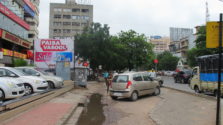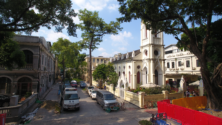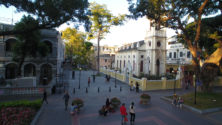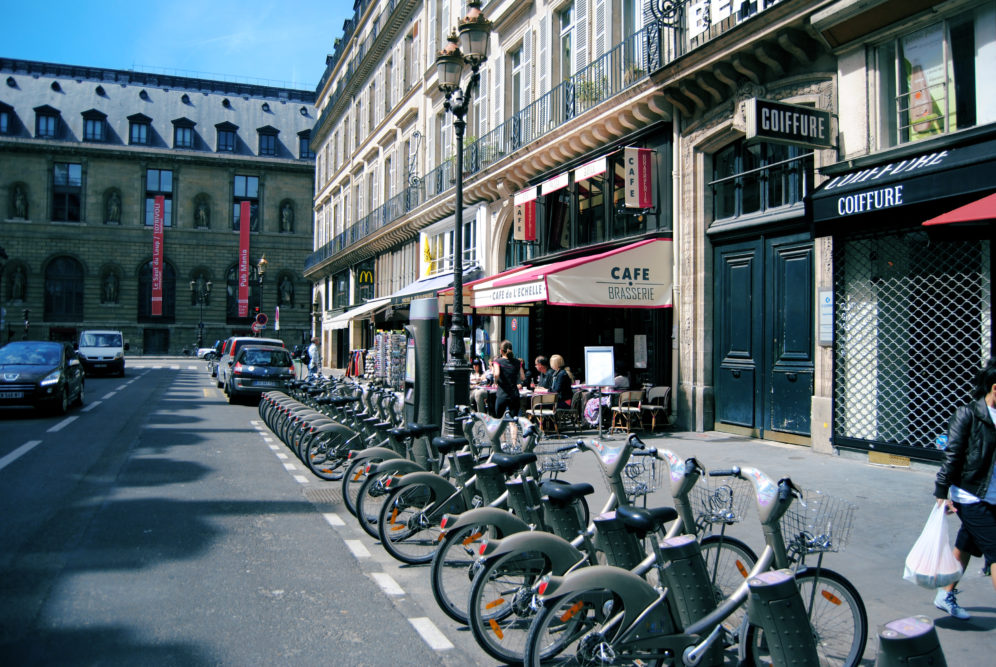 In Paris, previous parking spaces have been reallocated to many "velibs," of the citywide bikeshare program.
In Paris, previous parking spaces have been reallocated to many "velibs," of the citywide bikeshare program.
September 15, 2021
Equitable Streets Start with Parking Reform
In the past months, two hurricanes, Henri and Ida, devastated the South and Northeast regions of the United States, while forest fires raged in the west. Recent flooding due to record rainfall in Germany and Belgium killed more than 200 people. Tsunami and Hurricane seasons are extending. Heatwaves scorched the Middle East and South Asia. Extreme weather events like these have been discussed in the recent UN report on climate change and its impacts on the planet.
To fight these devastating and ever unprecedented weather events, it is clear that we need a transportation system with fewer cars. Better managed parking is crucial to getting more cars off the road; by both reducing the need to drive and enabling cities to shift space to other modes, such as walking, cycling and transit.
Parking minimums come from an assumption that cars are the sole, and most efficient form of transportation and required a built environment exclusively for the motor vehicle. Despite knowing about cars and their damaging effects, parking minimums remain a norm. Motor vehicles, in their ubiquity, are viewed as the default or preferred mode but cars have never been inevitable, just a policy choice that developers and cities make again and again.
Prioritizing parking over people
Parking has always been fundamental to driving. While parking may be viewed as a response to driving, in reality it often serves as a motivating force. Most cities, struggling with increasing traffic, have dedicated more and more public space to driving and to free vehicle storage (parking), assuming that “parking problems” come from a shortage of parking spaces. Part of this assumption has given way to many cities providing free or underpriced parking on the street, as well as maintaining off-street parking minimums. Parking minimums require commercial and residential developers to provide a minimum number of off-street parking spaces regardless of demand. These common ordinances play a major role in creating sprawl and preventing dense and transit-oriented development. In fact, the choice to provide so much free parking has made it cheaper to drive, leading to even more traffic. This in turn has led to environments in which very few destinations are walkable, where roads are hostile to both pedestrians and cyclists, and where public transit is underfunded and therefore unreliable. Ultimately, more parking means more driving and more driving brings along a myriad of deadly consequences: from traffic violence to air quality, dangerous outcomes for both drivers and non-drivers.
Rethinking street space
On-street parking is parking on streets which is either free or paid by meters. Off-street parking includes parking lots and parking garages; this is often regulated with parking minimums for builders. Both types of parking function similarly in terms of increased demand and the impact on cities and air quality. On-and off-street parking directly impact one another. Off-street parking reform relies heavily on successful on-street parking management: Off-street lots or garages will be underutilized as long as on-street parking is free or priced very low. While it is ideal for cities to address on- and off-street parking together, it can be more feasible to manage on-street parking as a first step.
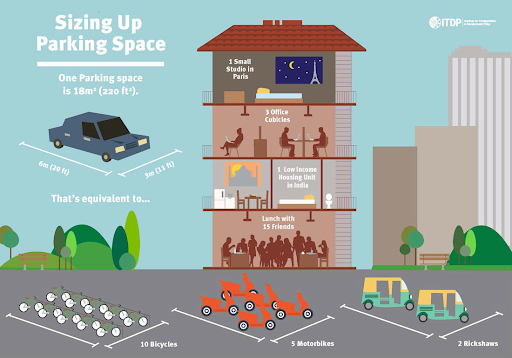
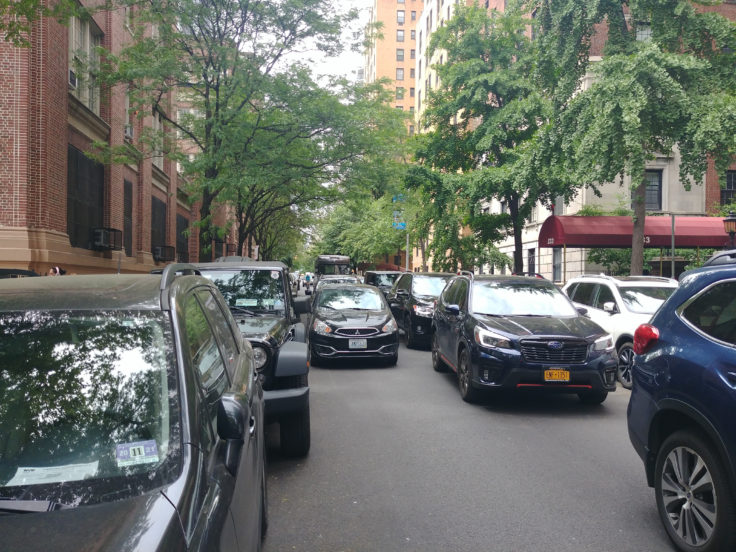
Restrictions from COVID-19 gave cities permission to reclaim curb space, with many cities reallocating it away from car storage and utilizing it for more efficient and equitable means like bicycle lanes, bus lanes, restaurant seating, and other public uses. Not only has this reclamation led to more engaged and active streets – helping to revitalize cities during a dark time; but it has challenged long held assumptions about the dominant use of curb space to store parked vehicles. Worldwide, hundreds of kilometers of new bicycle lanes have popped up, and in many cities entire streets have been closed off to cars, transforming how people view and experience the street — in some cases overnight. Currently, the previously held status quo of parking has re-entered the conversation. As some cities begin their “return to normal,” the decision of giving more space and priority to people over parked cars can be maintained. Effective parking management plays a crucial role in this future.
In Guangzhou, on-street parking was taken over to create appealing and safe pedestrian space.
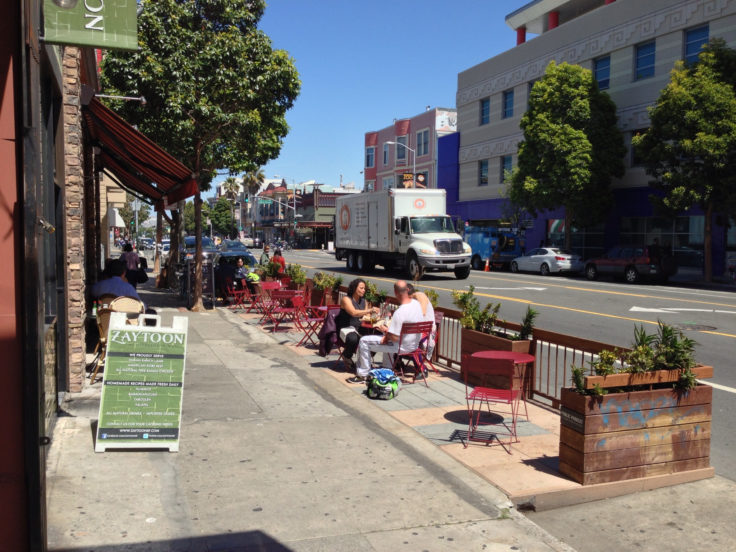
Parking management as a Tool for Sustainable Transport
ITDP has long supported parking management as an important tool to help cities achieve a more sustainable transportation system and better utilize our limited and valuable street space for things like bus lanes, bicycle lanes, wider sidewalks, and flexible loading/unloading zones. The revenue from priced parking can help fund these improvements. However, implementing parking reform has been challenging for many cities around the world, especially where drivers come from groups with political influence and present strong opposition to a change in the status quo. When the pandemic gave an opportunity to rethink the use of this space, that re-imagination ought to be realized before it’s too late.
To support better parking management, this week ITDP released an On-Street Parking Pricing Guide, a resource for cities that have made the choice to better manage parking to answer the critical question: how do we do it? The guide provides practical implementation steps and recommendations to manage parking more efficiently, with a focus on how to contract for and operate, enforce, and evaluate success of on-street parking. It also provides the foundation cities need to develop a parking program that operates in tandem with broader transportation demand management, public space, and livability goals.
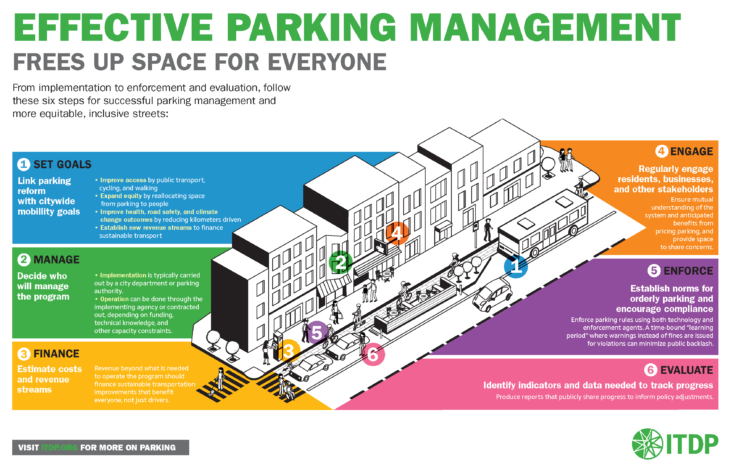
Throughout this week, ITDP will be sharing resources and stories on parking leading up to Park(ing) Day on Friday, September 17, 2021. We are keeping the conversation going with a webinar on September 28: Accelerating Parking Reform in the US: Parking and Land Use
Register here.
Other ITDP Parking resources include:
- STREETSFILMS produced “Parking: Searching for the Good Life in the City” – this video takes note of historical precedence and misconceptions about parking
- Taming Traffic – a 2021 paper about traffic mitigation strategies for all cities, including parking strategies
- Mexico City Timeline – this interactive page provides history on how Mexico City became a Leader in Parking Reform
- US Parking Policies: An Overview of Management Strategies – this 2010 publication includes case studies from US cities
- Mas ciudad, menos cajones – CDMX – this paper is about on-street parking strategies implemented in Mexico City and their success particularly in improving air quality (English version here)
- Parking and Travel Demand Management Policies in Latin America – this 2014 publication, also available in Spanish and Portuguese, surveys different Latin American cities and what parking strategies worked and didn’t work for them
- Parking Guidebook for Beijing – Identifies parking issues in Beijing, and offers Chinese and international best practices; recommendations for on- and off-street parking, as well as communication about parking reform are offered
- Europe’s Parking U-Turn: From Accommodation to Regulation – this 2011 paper explores the changes in European cities with consequences and important lessons for other cities today
- Parking Basics – This informative and visually engaging guide, published by ITDP India, lays out clear steps and instructions for parking implementation


